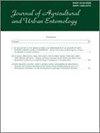发光二极管光陷阱作为一种改进的家蝇控制方法(直翅目:蝇科)
Q2 Agricultural and Biological Sciences
引用次数: 0
摘要
家蝇(Musca domestica L.,双翅目:蝇科)普遍存在,并传播许多导致人类疾病的病原体(Scott & Lettig 1962, Greenberg 1965, Keiding 1986)。因此,必须在医院、学校和处理和/或销售食品的设施(杂货店、餐馆、市场等)控制其人口。家蝇传播的病原体包括引起沙门氏菌病、炭疽、眼病、志贺氏菌病、结核病、霍乱和婴儿腹泻等疾病的细菌;引起阿米巴痢疾的原生动物;蠕虫感染,如蛲虫、蛔虫、钩虫和绦虫;还有病毒和立克次体感染。家蝇可以传播一种致命的大肠杆菌(Migula)、Castellani和Chalmers(肠杆菌科)(Sasaki等人,2000年)和其他威胁生命的抗生素耐药细菌(Rahuma等人,2005年,Macovei和Zurek, 2006年),这些细菌对医院和其他医疗机构构成日益严重的威胁(Sundin 1996, Graczyk等人,2001年,Maisnier-Patin和Andersson, 2004年,Boulesteix等人,2005年)。大量研究表明,控制家蝇可以限制人类疾病的传播(Watt & Lindsay 1948, Lindsay et al. 1953, Bian et al. 2018)。在一些使用杀虫剂可能有问题的环境中,如餐馆、学校、杂货店、医院等,需要对家蝇进行非化学控制。在这些设施中,捕光器是杀虫剂的有效替代品。昆虫捕光器通常依靠紫外线光源作为引诱剂,一种常见的家蝇捕光器设计包括一个壁挂式光源和位于灯后面的胶板。在310和370 nm之间的波长对果蝇的吸引力最大(Thimijan& Pickens 1973),它们对光源的吸引力取决于光源的强度(Thimijan& Pickens 1973)、陷阱的设计(Thimijan& Pickens 1973, Pickens & Thimijan 1986, Syms & goodman 1987, Rutz等人1988,Roberts等人1992,Hogsette 2008)和开关周期(Hogsette 2019)。基于紫外线的捕集器本文章由计算机程序翻译,如有差异,请以英文原文为准。
Light-Emitting Diode Light Traps as an Improved Method for Control of Musca domestica (Diptera: Muscidae)
House flies, Musca domestica L. (Diptera: Muscidae), are ubiquitous and transmit scores of pathogens which cause human diseases (Scott & Lettig 1962, Greenberg 1965, Keiding 1986). As a result, their populations must be controlled in hospitals, schools and facilities that handle and/or sell food (grocery stores, restaurants, markets, etc.). Pathogens transmitted by house flies include bacteria causing diseases such as salmonellosis, anthrax, ophthalmia, shigellosis, tuberculosis, cholera, and infantile diarrhea; protozoa that cause amebic dysentery; helminthic infections such as pinworms, roundworms, hookworms, and tapeworms; as well as viral and rickettsial infections. House flies can spread a deadly strain of Escherichia coli (Migula) Castellani & Chalmers (Enterobacteriaceae) (Sasaki et al. 2000) and other life threatening antibiotic resistant bacteria (Rahuma et al. 2005, Macovei & Zurek 2006) which constitute an ever increasing threat in hospitals and other healthcare facilities (Sundin 1996, Graczyk et al. 2001, Maisnier-Patin & Andersson 2004, Boulesteix et al. 2005). Numerous studies have shown that control of house flies can limit transmission of human diseases (Watt & Lindsay 1948, Lindsay et al. 1953, Bian et al. 2018). There are needs for non-chemical control of house flies in some environments where the use of insecticides can be problematic, such as restaurants, schools, grocery stores, hospitals, etc. Light traps represent an effective alternative to insecticides in these facilities. Insect light traps typically rely on a UV light source as an attractant, and a common trap design for house flies consists of a wall-mounted light source with a glue board situated behind the lights. House flies are attracted most strongly to wavelengths between 310 and 370 nm (Thimijan& Pickens 1973), and their attraction to the light source depends on the intensity of the light source (Thimijan & Pickens 1973), the design of the trap (Thimijan & Pickens 1973, Pickens & Thimijan 1986, Syms &Goodman 1987, Rutz et al. 1988, Roberts et al. 1992, Hogsette 2008) and the on/off cycle (Hogsette 2019). UV light based traps have
求助全文
通过发布文献求助,成功后即可免费获取论文全文。
去求助
来源期刊

The Journal of Agricultural and Urban Entomology
Agricultural and Biological Sciences-Insect Science
CiteScore
1.40
自引率
0.00%
发文量
2
期刊介绍:
The Journal of Agricultural and Urban Entomology (JAUE) (Journal of Agricultural Entomology, Jan 1984 - Oct 1998 volumes 1-15) is published under the auspices of the South Carolina Entomological Society (SCES). The Journal publishes contributions of original research concerning insects and other arthropods of agricultural and urban importance to include those affecting humans, livestock, poultry, and wildlife. JAUE is particularly dedicated to the publication of articles and notes pertaining to applied entomology, although it will accept suitable contributions of a fundamental nature related to agricultural and urban entomology.
 求助内容:
求助内容: 应助结果提醒方式:
应助结果提醒方式:


